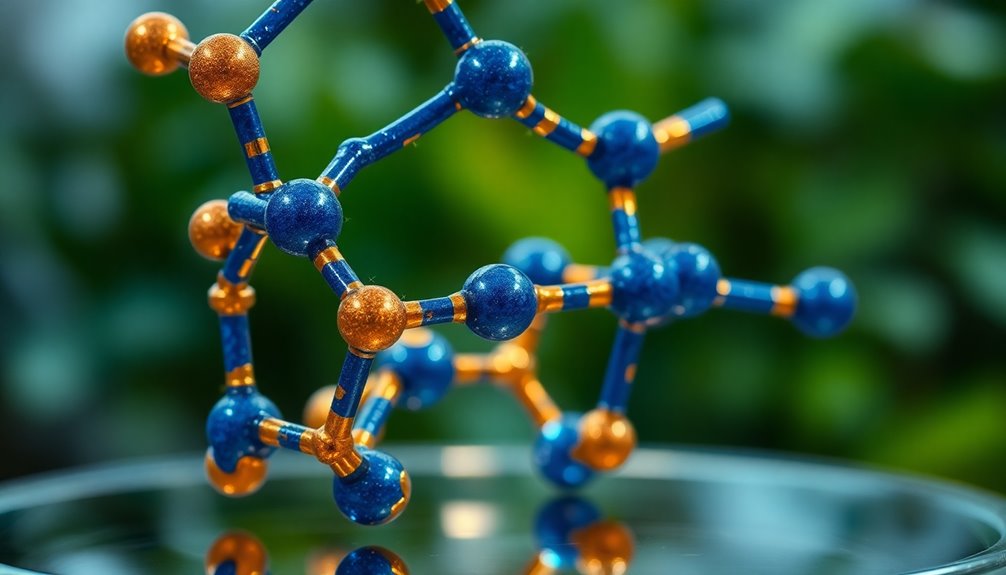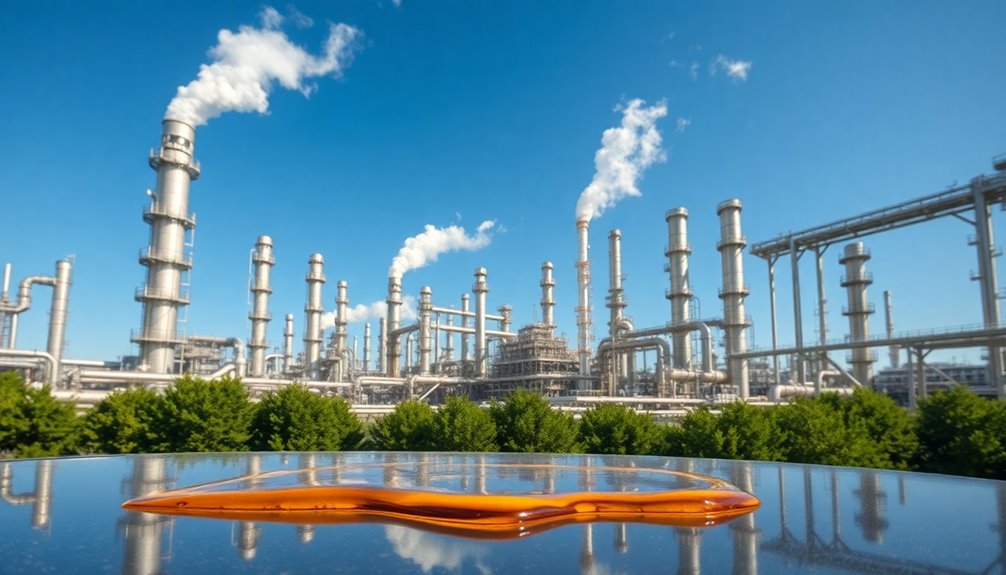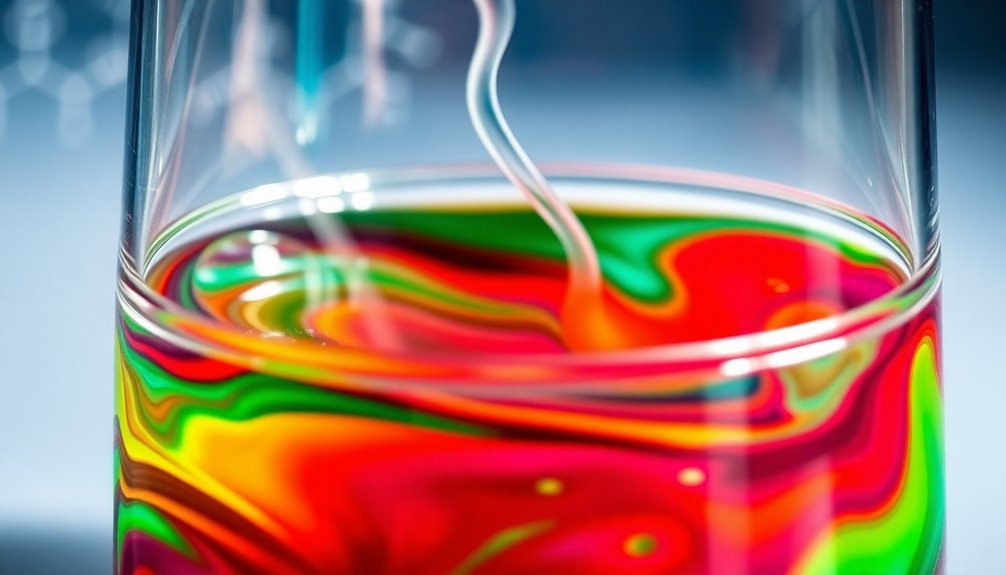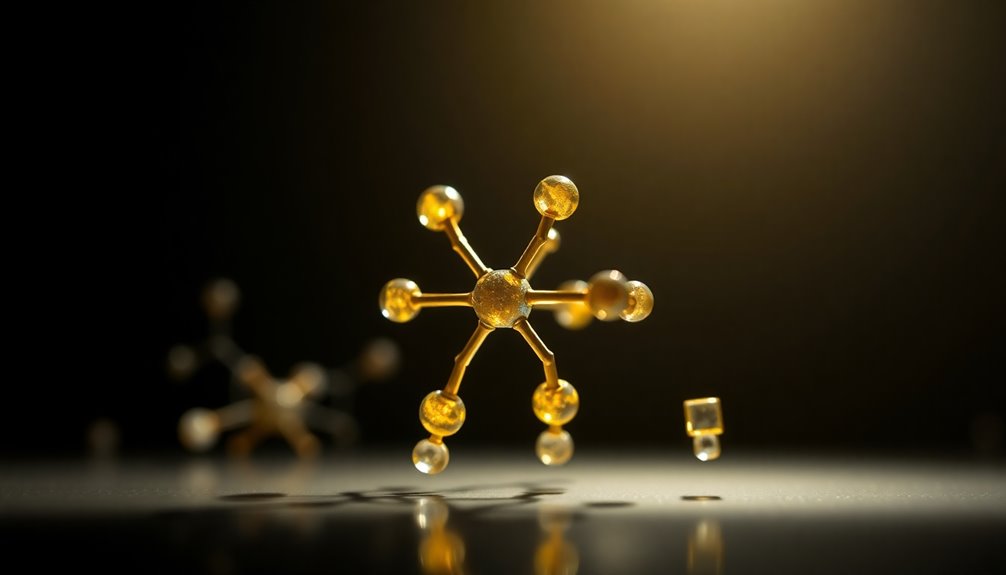Aromatic hydrocarbons, often called arenes, are intriguing compounds that feature one or more benzene rings. They're characterized by their stable structure, which allows for electron delocalization. The simplest example is benzene (C6H6), a flat, six-carbon arrangement with hydrogen atoms. These compounds primarily come from petroleum, and they play roles in industries like fuel and plastics. However, they also pose health risks, as some are linked to cancer. Their environmental impact on air quality is significant too, affecting urban pollution levels. Want to learn about their microbial degradation and future research directions?
Key Takeaways
- Aromatic hydrocarbons, or arenes, contain one or more benzene rings characterized by a hexagonal arrangement of carbon atoms.
- Benzene, the simplest aromatic compound, has delocalized π electrons that contribute to its stability and aromaticity.
- Major sources of aromatic hydrocarbons include petroleum, coal, vehicle emissions, and biomass burning.
- Long-term exposure to aromatic hydrocarbons, especially benzene, poses significant health risks, including cancer and respiratory diseases.
- Microbial degradation of aromatic hydrocarbons is crucial for bioremediation, utilizing specific bacteria and fungi to detoxify contaminated environments.
Definition of Aromatic Hydrocarbons

Aromatic hydrocarbons, often referred to as arenes, are intriguing compounds defined by one or more benzene rings in their structure. The simplest of these aromatic compounds is benzene (C6H6), featuring a planar arrangement with six carbon atoms and delocalized π electrons.
This unique structure leads to equal carbon-carbon bond lengths of 1.397 Å, a hallmark of aromaticity. Because of resonance stabilization, aromatic hydrocarbons are typically less reactive than their aliphatic counterparts, favoring substitution reactions rather than addition reactions.
Additionally, you'll find that polycyclic aromatic hydrocarbons (PAHs), like naphthalene (C10H8) and anthracene (C14H10), consist of multiple fused benzene rings.
These aromatic hydrocarbons play an essential role in various industries, serving as key intermediates in producing dyes, plastics, and pharmaceuticals.
Structural Characteristics

Aromatic hydrocarbons feature a unique benzene ring structure that's both planar and stable.
You'll notice that the alternating single and double bonds create equal bond lengths due to resonance, contributing to their stability.
Understanding these bonding characteristics is key to grasping the overall behavior of these compounds.
Benzene Ring Structure
The benzene ring structure showcases a unique hexagonal arrangement of six carbon atoms, each bonded to a single hydrogen atom, creating a flat, planar configuration.
This arrangement allows each carbon atom to participate in hybridization, forming alternating sigma and delocalized π bonds, resulting in a resonance structure.
You'll notice that the bond lengths between carbon atoms in benzene are all equal at approximately 1.397 Å, thanks to the delocalization of π electrons across the ring.
Benzene also follows Hückel's rule, having 6 π electrons, which confirms its aromatic nature.
This stability allows benzene rings to resist many chemical reactions without significant alteration, a characteristic known as aromaticity, making them essential in organic chemistry.
Bonding and Stability
Understanding the benzene ring structure leads you to appreciate the bonding and stability that characterize aromatic hydrocarbons.
In benzene, six carbon atoms form a planar hexagonal ring, each bonded to a hydrogen atom. The bonding involves alternating sigma (σ) and delocalized pi (π) bonds, where π electrons are evenly distributed across the ring, enhancing stability.
This resonance results in equal carbon-carbon bond lengths of 1.397 Å, rather than alternating single and double bonds. The concept of aromaticity, defined by Hückel's rule, indicates that benzene's six π electrons (4n + 2) contribute to its unique stability.
Consequently, aromatic hydrocarbons resist typical addition reactions, favoring substitution reactions due to their resonance stabilization.
Sources and Production

When you think about aromatic hydrocarbons, consider petroleum as their main production source, with significant quantities also found in coal.
These compounds play essential roles in various industries, from motor fuels to pharmaceuticals.
However, their contribution to air quality issues can't be overlooked, as they account for about 10% of global nonmethane organic carbon emissions.
Major Production Sources
While aromatic hydrocarbons are commonly associated with petroleum, they actually originate from a variety of sources, including coal and natural processes. In fact, the U.S. produced around 6.74 million liters of benzene in 2000, showcasing the importance of these compounds in production.
Major production sources include car exhaust from gasoline-powered vehicles, solvent usage, and biomass burning. These activities not only generate aromatic hydrocarbons but also contribute to urban air pollution, releasing volatile organic compounds that affect air quality.
Though they make up only a few percent of total hydrocarbons, isomers like xylenes are essential for various industrial applications, including motor fuel, dyes, and plastics. Understanding these sources helps you appreciate the role of aromatic hydrocarbons in our environment.
Industrial Applications Overview
Aromatic hydrocarbons, like benzene, toluene, and xylene (collectively known as BTX), are crucial building blocks in the chemical industry. These organic compounds serve a variety of industrial applications due to their unique chemical properties. They're important for producing plastics, dyes, and pharmaceuticals, showcasing their versatility. In the U.S. alone, about 6.74 million liters of benzene were produced in 2000, emphasizing its significance. Additionally, isomers of these hydrocarbons, such as xylenes, are essential in various sectors.
| Aromatic Hydrocarbon | Key Uses | Chemical Properties |
|---|---|---|
| Benzene | Plastics, Pharmaceuticals | Highly reactive |
| Toluene | Solvents, Dyes | Moderate reactivity |
| Xylene | Intermediates, Agriculture | Diverse isomeric forms |
| Ethylbenzene | Styrene production | Stable under standard conditions |
| Cumene | Phenol production | Combines well with others |
Environmental Emission Contributions
The production and use of aromatic hydrocarbons not only meet industrial needs but also contribute greatly to environmental emissions. Major sources include car exhaust from gasoline-powered vehicles, solvent usage, and biomass burning, which considerably impact urban air quality.
These compounds, particularly polycyclic aromatic hydrocarbons, account for about 10% of global anthropogenic nonmethane organic carbon emissions. In urban areas, they contribute to 30-40% of ozone production, playing a vital role in photochemical reactions.
While aromatic hydrocarbons are more prevalent in coal, they're primarily produced from fossil fuels, particularly petroleum. In 2000, the U.S. alone produced 6.74 million liters of benzene, highlighting the large-scale industrial reliance on carbon-carbon bonds inherent in these compounds.
Health Risks and Toxicity

Given their widespread use and prevalence in the environment, understanding the health risks associated with aromatic hydrocarbons is vital.
Benzene compounds, a key focus in organic chemistry, are classified as Group-A human carcinogens by the US EPA. Long-term exposure can lead to serious health effects, including hematotoxicity and an increased risk of leukemia.
Polycyclic aromatic compounds, particularly those found in secondary organic aerosols, can produce mutagenic products, raising further concerns.
Occupational exposure to certain aromatic hydrocarbons, like 1,2-benzopyrene, has been linked to elevated skin cancer rates, particularly among chimney sweeps in London.
It's essential to implement regulatory measures to reduce exposure, as aromatic hydrocarbons pose significant risks to both health and the environment.
Environmental Impact

Understanding the health risks associated with aromatic hydrocarbons naturally leads to concerns about their environmental impact.
These compounds, characterized by their aromatic rings, contribute about 10% to global anthropogenic nonmethane organic carbon emissions, severely affecting air quality, especially in urban areas.
Benzene derivatives play a significant role in ozone formation, accounting for 30-40% of urban ozone levels due to their high reactivity.
Emissions from sources like car exhaust and biomass burning generate secondary organic aerosols (SOAs), which are harmful and contribute to climate change.
In densely populated regions, the concentration of these pollutants exacerbates local air pollution issues, posing health risks to you and your community.
Understanding these impacts is essential for addressing pollution and protecting public health.
Microbial Degradation

Microbial degradation of aromatic hydrocarbons plays an essential role in cleaning up contaminated environments, as specific bacteria and fungi can metabolize these compounds for energy and carbon.
This natural process is vital for effective bioremediation. Here are some key points about microbial degradation:
- Certain phyllosphere fungi can break down hazardous compounds like xylene and toluene.
- Environmental factors like temperature, pH, and nutrient availability influence degradation efficiency.
- Various bacterial strains have been isolated for aerobic degradation of aromatic hydrocarbons.
- Microbial cells can produce specific metabolic enzymes that enhance breakdown and detoxification.
Research Challenges and Future Directions

As researchers explore deeper into the complexities of aromatic hydrocarbons, they encounter significant challenges that hinder a full understanding of their environmental impact and degradation processes.
Current knowledge about the oxidation mechanisms of these aromatic compounds and their role in ozone production remains limited. You'll find that investigating atmospheric organic aerosol formation from aromatic emissions is essential for evaluating air quality and human health.
Additionally, global cellular responses in the metabolism of aromatic hydrocarbons are poorly characterized, with many metabolites and enzymes still unidentified.
To bridge these gaps, integrative approaches are necessary, especially in studying biodegradation pathways. Continued research in these areas will pave the way for effective bioremediation strategies and enhance our understanding of aromatic compounds.
Frequently Asked Questions
What Are the Aromatic Hydrocarbons?
Aromatic hydrocarbons are a fascinating class of compounds you might encounter in various industrial applications. They feature one or more benzene rings, which give them unique properties.
When you look at their structure, you'll notice the planar arrangement and delocalized electrons. Examples include benzene and naphthalene, with sources like car exhaust and biomass burning contributing to their presence in the environment.
Understanding these compounds can enhance your knowledge of chemistry and its applications.
How Do You Know if a Hydrocarbon Is Aromatic?
To determine if a hydrocarbon's aromatic, check for a planar ring structure with delocalized π electrons.
Confirm it follows Hückel's rule, meaning it has 4n + 2 π electrons, where n is a non-negative integer.
Look for equal bond lengths, indicating resonance stability.
If you find substituents, they can influence reactivity, so consider how they might affect the hydrocarbon's behavior in reactions like electrophilic aromatic substitution.
Which Is a Characteristic of Aromatic Hydrocarbons?
Isn't it ironic how something so stable can be so reactive? A key characteristic of aromatic hydrocarbons is their unique stability, thanks to delocalized π electrons in their structure.
You'll find that these compounds follow Hückel's rule, which dictates specific electron counts for aromaticity. They're less reactive than aliphatic hydrocarbons, often undergoing substitution reactions instead of additions, allowing them to maintain their aromatic properties while incorporating new substituents.
What Is the Difference Between Hydrocarbons and Aromatic Hydrocarbons?
Hydrocarbons are organic compounds made solely of hydrogen and carbon atoms, while aromatic hydrocarbons are a specific type that includes one or more benzene rings.
You'll notice that aromatic hydrocarbons exhibit unique stability due to their resonance, making them less reactive than aliphatic hydrocarbons.
Additionally, aromatic hydrocarbons are inherently unsaturated, unlike aliphatic ones, which can be either saturated or unsaturated.
This structural difference considerably impacts their chemical behavior and environmental effects.
Conclusion
In conclusion, aromatic hydrocarbons are like double-edged swords; they're essential in many industries but come with significant health and environmental challenges. Understanding their structure and sources helps you grasp their impact on health and the planet. As researchers tackle the complexities of microbial degradation, we can hope for cleaner solutions in the future. By staying informed and proactive, you can contribute to a healthier environment while steering through the world of these fascinating compounds.

















